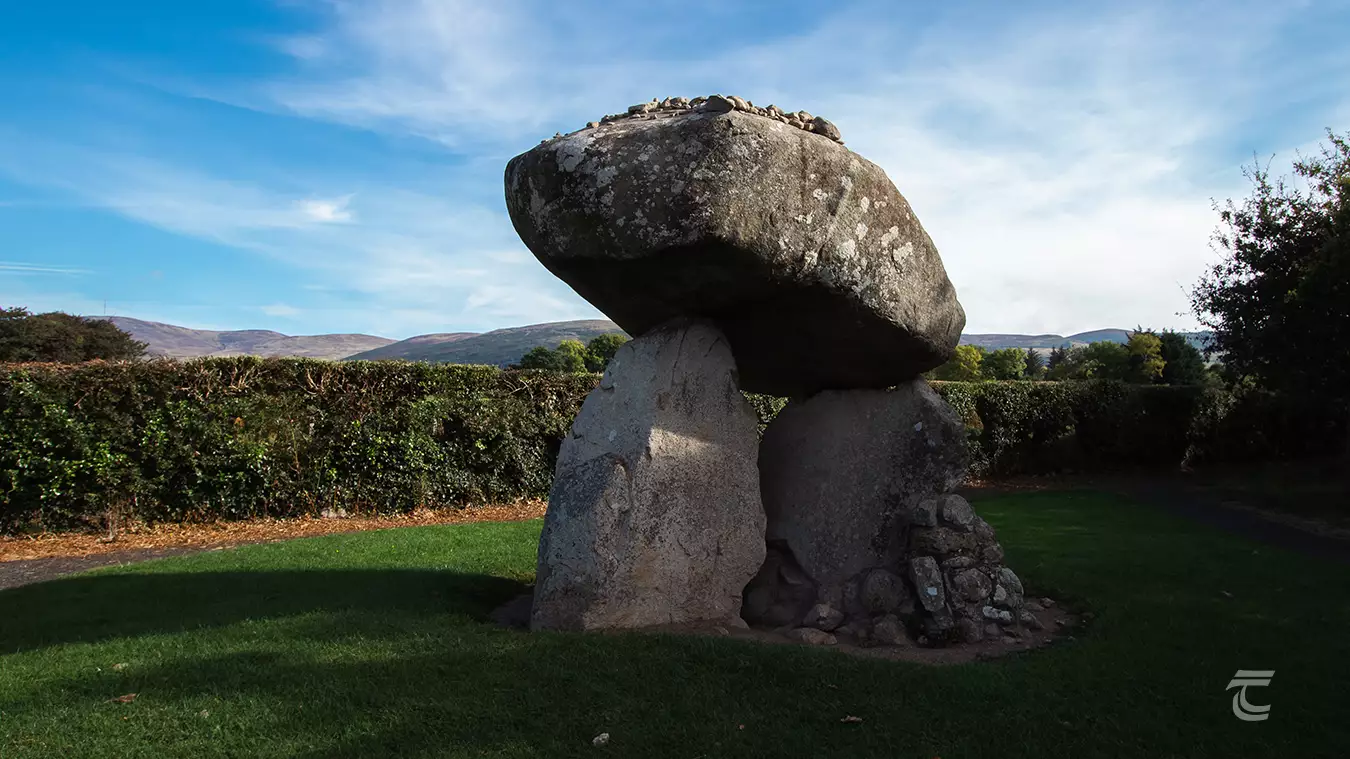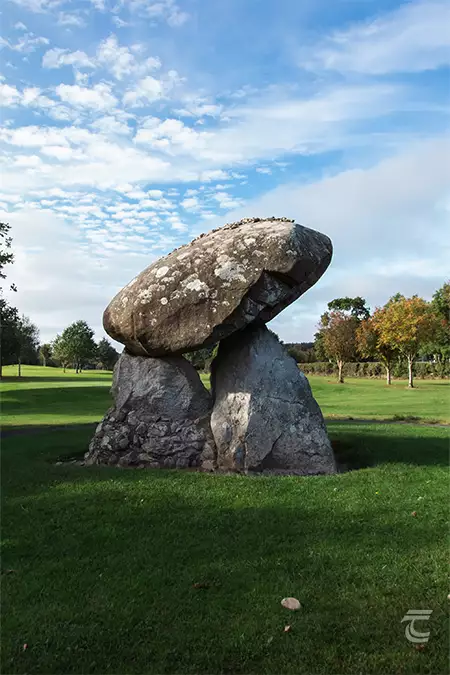Proleek Dolmen
Within the golf course of Ballymascanlon House Hotel you can find two iconic reminders of County Louth’s ancient past. The Proleek Dolmen is one of Ireland’s most famous examples of a portal tomb. This is one of over 170 portal tombs (also known as dolmens) recorded in Ireland. Portal tombs generally date to the earlier part of the Neolithic period (c.3800–3500 BC). Geographically they are more common in the northern half of the island, with some clusters in the west and the south-east. This example at Proleek consists of two large upright stones (known as portal stones), each measuring over 2 metres (6.5 ft) tall, and a back stone supporting a massive capstone that is estimated to weigh over 40 tonnes.
Just a short distance away is a fine example of a wedge tomb. Wedge tombs are the most numerous of Ireland’s megalithic tombs, with around 505 known examples around the country. This is a later monument than the portal tomb, and was probably constructed some time around 2500 BC, around the end of the Neolithic period and the beginning of the Bronze Age, in a transitional period known to archaeologists as the Chalcolithic. This is the time when the first copper and metal tools began to be made in Ireland. This era is also known as the Beaker Period, due to the appearance of a particular type of pottery drinking vessel. You can hear a great discussion on the Beaker People with Dr. Neil Carlin in this episode of our Amplify Archaeology Podcast. The proximity of the two monuments is interesting – the portal tomb had already stood here for millennia before the wedge tomb was constructed. Those who built the later tomb are quite likely to have been from a completely different cultural background (perhaps even a genetically different), though they must have attached meaning and significance to the older monument to leave it untouched and to build their own in its shadow.
For practical information about visiting this site Click Here

Proleek Dolmen • Louth
The Folklore of Proleek Dolmen

Proleek Dolmen stands on the golf course at Ballymascanlon House Hotel • Louth
A number of interesting stories associated with the Proleek Dolmen can be found in the fantastic School’s Folklore Collection. One collected by a teacher by the name of James Mc Creesh of the Dulargy School, Louth, wrote of the mythological origins of the dolmen:
‘It is locally called the giant’s load and it is said the giant who put it up got his death of drinking of waters from the river these being poisoned by an enemy. Others say it is a monument over some mighty chieftain of old, but in truth little is known about its origin… About 100 yards from the cromlech is an enclosure in the shape of a grave. It is locally called the “giant’s grave” meaning of course that the giant who met his death as the result of the poisoned waters lies in it.’
Local folkloric tradition suggests that you will be married within the year if you can throw a small pebble back over your head and it lands on top of the capstone without rolling off, and it’s clear that some people continue the tradition to this day (though being a killjoy I’m always a little nervous of people throwing rocks at an ancient tomb!). This is something which is mentioned in the recording of Betty Bowden, a student of Presentation Convent, Drogheda, from an account given by Mr Bill Wissitt:
‘The people of the district tell us, that if you can place three stones without falling on top of the big stone you will be married inside a year. Old people warn us to clear out of the place before 6 o’clock or wee people will carry you away for ever. It is said to be a great meeting place of the fairies. The old people tell us that they have often seen the small red man.’

Proleek Dolmen stands on the golf course at Ballymascanlon House Hotel • Louth
Upper left: The nearby wedge tomb • Lower left: Note the small stones on the top of the capstone, part of an old tradition • Right: The portal tomb
Top: The nearby wedge tomb • Middle: The portal tomb • Bottom: Note the small stones on the top of the capstone, part of an old tradition
Proleek Dolmen Visitor Information
Explore more sites in Ireland’s Ancient East


